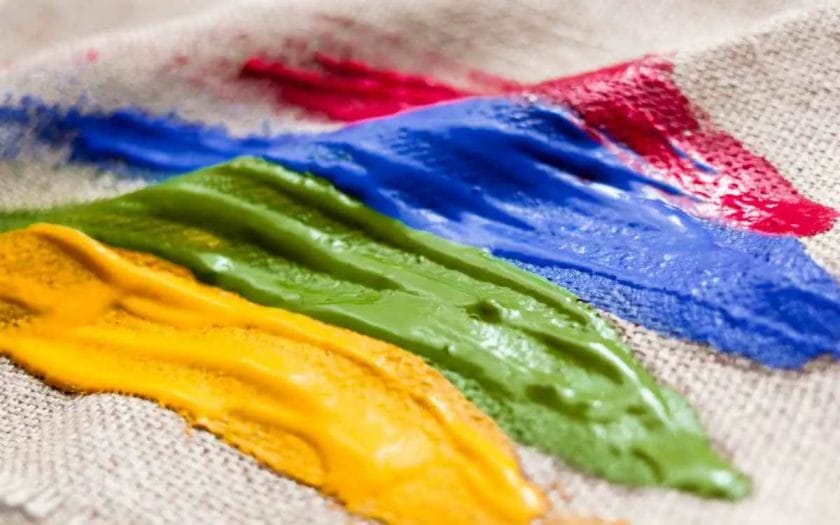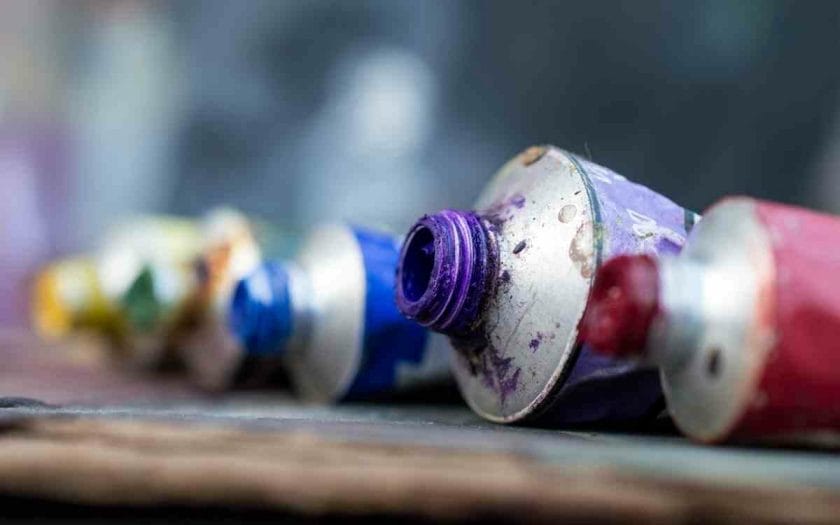When it comes to choosing the right type of paint for your project, the options can be overwhelming. Should you use acrylic or tempera paint? What are the differences between the two?
In this blog post, we will discuss the pros and cons of each type of paint, so that you can make an informed decision about which one is right for you.

Acrylic Paint vs. Tempera Paint
Here is a clear comparison between acrylic paint and tempera paint:
Composition
Acrylic and tempera paint are both water-based paints, but that seems to be the only similarity between them.
The composition of acrylic paint is very different from that of tempera paint.
Acrylic paints are made from synthetic pigments and binders. These combinations give acrylic paint its texture and flexibility.
Its color pigments are granular solids that don’t dissolve completely but are suspended in polymer emulsion.
Acrylic paints are water-based and can be thinned with water. But it becomes water-resistant once it has dried. This is because water acts as the driver and once it evaporates, it leaves other ingredients behind, which makes the paint now become water-resistant.
Tempera paints are composed of pigment, water, and a binder. Tempera paints are of different kinds and each type is differentiated based on the type of binder present in it. There are egg tempera paints, poster colors, top-tier tempera paints, and so on.
The professional quality tempera paint known as Egg tempera consists of colored pigments mixed with gelatinous water-soluble binders such as egg yolk, hence the reason behind its name.
It is a permanent, fast-drying painting medium and its paintings are very long-lasting. It is mostly used professionally and is quite expensive.
Craft tempera paint, also known as Poster color, is a type of tempera paint made with simple compositions such as calcium carbonate and starch.
This type of tempera paint is intended to be safely used by kids for painting projects and finger painting and it is non-toxic.

Consistency
Tempera paint and acrylic paint have different consistency. Tempera paints have a thin and creamy consistency and they can be used straight out of the bottle without thinning them with water.
Some tempera paints are available in powder and cake forms that can be mixed with water to make paints.
Acrylic paints are always in liquid form and thicker than tempera paints. They are also available in different consistencies such as fluid acrylics, heavy body, soft body, and so on.
Also, the consistency of acrylic paints can be adjusted by mixing them with different mediums, especially water.
Longevity of Artworks
Artworks made with acrylic paints have a longer shelf life and can last for many years without fading or washing off.
Though paintings with egg tempera paint have a similar life span as paintings with acrylic paint, craft tempera paints give a shorter lifespan.

This is because the binders used in craft tempera paints are not as strong and durable as those used in professional quality egg tempera paints and acrylic paints.
Washability
Being water-soluble, you can reactivate tempera paint by adding water even if it’s dry. This makes tempera paint washable and easier to scrub off surfaces. This feature makes it the best choice for finger painting because it comes off with just soap and water.
On the contrary, acrylic paints don’t wash off once they are dry. They become water-resistant and can last for years, especially if they are properly sealed. But when acrylic paints are still wet, they can wash off when they come in contact with water.
Drying Time
The drying time of tempera paint is shorter than that of acrylic paint. Tempera paint dries to the touch within 15 minutes but can take up to 24 hours to completely cure.
Acrylic paint, on the other hand, takes about 30 minutes to dry to the touch and can take up to two weeks to fully cure.
Finish
Tempera paints dry to give a matte, chalky finish. Acrylic paints, on the other hand, leave a plastic-like, hardened texture with a semi-glossy to glossy finish when dry.
Acrylic paints are also available in a variety of finishes, such as metallic, matte, iridescent, and so on.
Thinning
When working with tempera paints, you don’t need to thin it with water because it’s a readily thinned paint. When you try mixing it with water, tempera paint looks very light with its pigment washed off.
However, Acrylic paints can be thinned with either water or other thinning mediums. They have a thick consistency with high pigment concentration that can’t be easily washed off. When thinned with water, Acrylic paint still maintains its opacity.

Toxicity
All types of tempera paints are non-toxic. However, acrylic paints may contain harmful chemicals such as ethyl acrylate and methyl methacrylate monomer. These chemicals can cause irritation to the skin, eyes, and respiratory system.
Therefore, it is important to read the label carefully before purchasing acrylic paint, especially if you are going to use it for kids’ painting projects.
Viscosity
The viscosity of tempera paint is lower than that of acrylic paint. This means that tempera paint flows more easily and has a thinner consistency.
The high viscosity of acrylic paint makes it ideal for creating texture on surfaces. It can also be used to build up layers on surfaces.
Layering
When painting with Acrylic, you can apply as many thick layers of paint on your work without worrying about cracking, but with tempera paints, adding thick layers of paint will create cracks in your painting.
Opacity
This is a factor that refers to the less transparency of the paint. Acrylic paints are available in both opaque and transparent forms, whichever you prefer depends on your preference. Nevertheless, opaque acrylic paint isn’t a match for tempera paint.
Tempera paint contains calcium carbonate, which makes it opaquer than acrylic paint. The calcium carbonate gives tempera paint a higher level of opacity and enables the paint to give excellent coverage even with one coat.
Lightfastness
This refers to a paint’s resistance to fading. Even when exposed to sunlight, acrylic paints are not likely to discolor or fade.
Lightfastness in acrylic paints also depends on the type and brand of the paint. You can get to know how lightfast acrylic paint is as it is most times indicated on the paint’s tube or can.
Generally, tempera paints are less lightfast than acrylic paints because of their washable nature. It’s advisable to keep tempera paintings indoors to protect them from fading.
Affordability
Acrylic paints tend to be more expensive than tempera paints. The prices also depend on how expensive or scarce the pigments used are. Artist-quality acrylics contain high-quality pigments in high concentrations which makes them quite expensive.
Acrylic paints also come in student and craft quality. Their pigment density is low and has more filler. They are cheaper than artist-quality acrylics.
Tempera paints are less expensive. Tempera paints use less expensive binders such as casein, cellulose, or starch. Also, they have little pigment density and the pigments are inexpensive.
What Paint is Best for What and Why?
Due to their different composition and features, tempera paints and Acrylic paints are suitable for different occasions, that is, you can’t use tempera paints for some of the projects that Acrylic paints can be used for.
Tempera paints
Tempera paints are best used for crafts projects, color mixing exercises, and kid’s finger paintings. They are best used on paper products such as poster boards, paper mache, cardboard, and the like.
Tempera paints can be used on canvas but it’s not advisable because it’s washable and doesn’t last long.
Acrylic paint
Acrylic paints are highly versatile and can be used for more classic and professional craft projects. They have high-quality colors and give your painting an excellent result. They are best used on canvas, wood, glass, leather, ceramics, plastic, paper, and so on.
Acrylic paint stays permanent and even after many years, it looks just as vibrant as it was after painting if sealed properly.
Conclusion
So, which paint should you use? It all depends on your project and what result you want to achieve.
If you want a long-lasting painting with excellent color quality, then acrylic paint is the best option. However, if you’re looking for less expensive paint for a craft project or kids’ painting, then tempera paint would be a better option.
